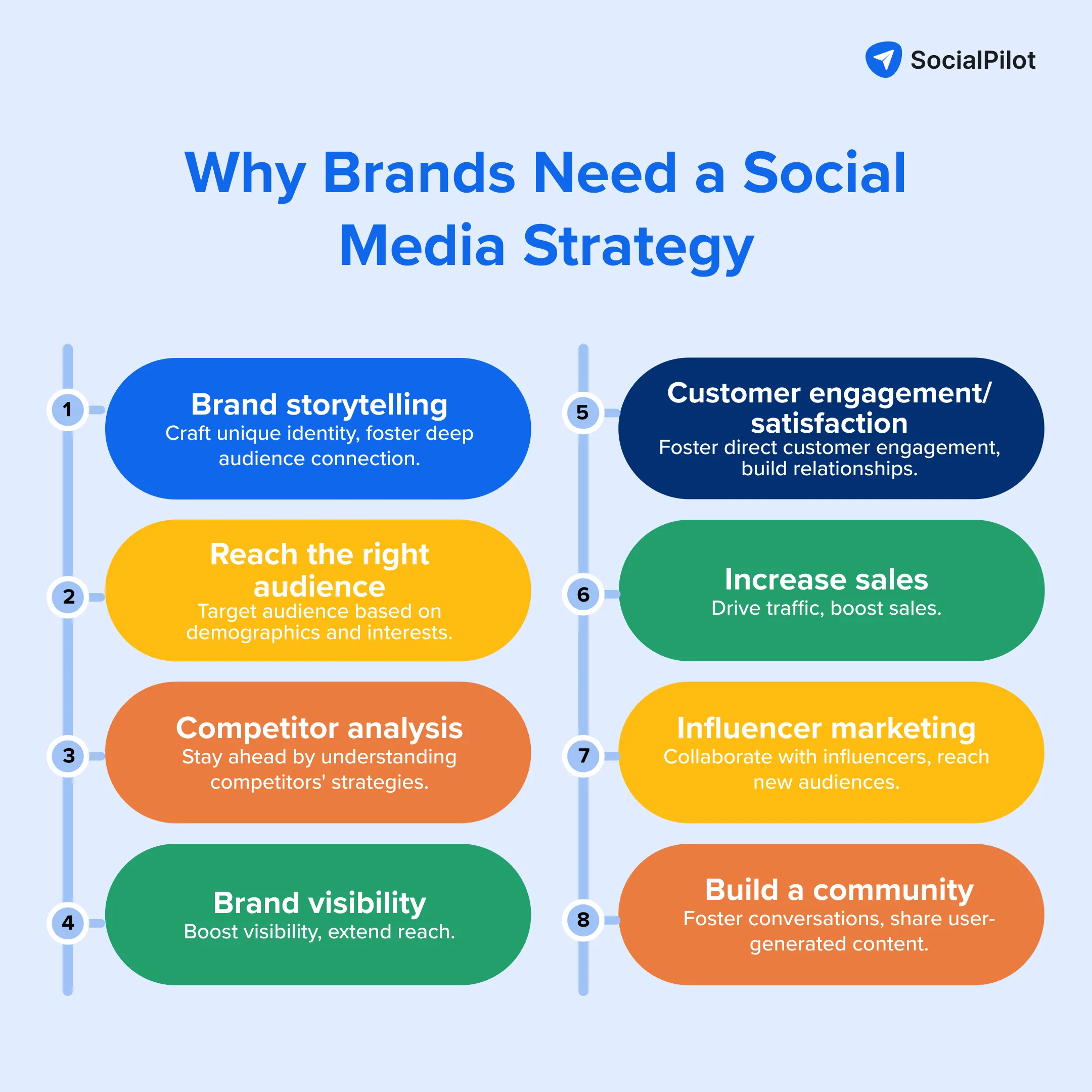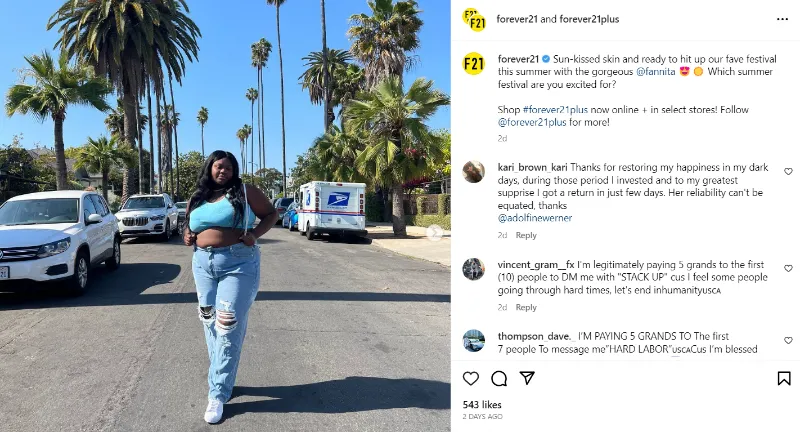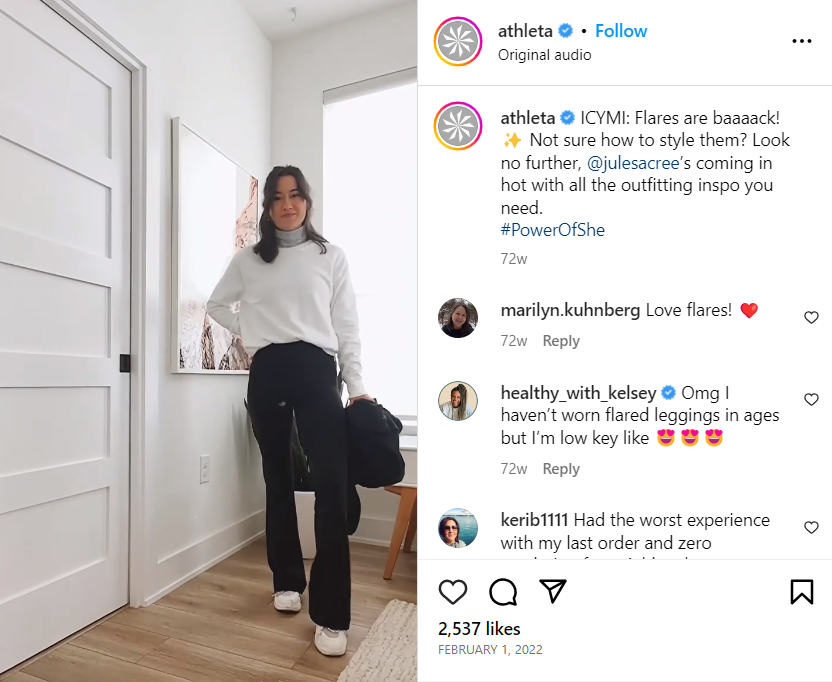There’s no question about it: social media has revolutionized the landscape of fashion marketing. With the fashion industry raking in a staggering global market revenue of 1.5 trillion, it’s clear that fashion brands are reaping the benefits of their hefty investments in social marketing.
But why is that?
Well, consider this: there are approximately 4.8 billion social media users worldwide spending 15% of their time waking time on social media platforms. Given these staggering statistics, fashion businesses clearly cannot ignore marketing their products on social platforms.
But is it possible for fashion businesses to excel at social selling without a concrete social marketing strategy in hand? Also, what resources do you need to market your products on social media successfully?
Stay tuned because this blog post is going to answer all these questions and more!
Top Social Media Network for Fashion Brands
With social selling projected to triple by 2025, it’s clear that marketing on social media platforms is more than just a trend—it’s a necessity. But which are the best social media platforms for fashion brands? Let’s find it out!
1. Instagram for Fashion Brands
Did you know that over 130 million Instagram users interact with shopping-related posts each month? This makes Instagram a powerful platform for fashion brands. Thanks to its visually-driven nature, Instagram allows brands to showcase their products in a way that’s both captivating and aspirational.
But that’s not all
Instagram’s emphasis on high-quality imagery and video content means brands can create visually stunning feeds, Stories, and Reels that enhance the appeal of their products. Plus, Instagram’s features, like shoppable posts and swipe-up links, provide a more immersive audience experience and drive traffic to your online store.
And let’s not forget about Instagram custom ad campaigns. By highlighting your best-selling apparel, these campaigns can attract new buyers and increase your brand’s visibility.
2. Facebook for Fashion Brands
With a massive user base of 2.85 billion users, Facebook is an excellent choice for fashion brands to expand their reach. The platform offers robust advertising capabilities that allow you to target specific demographics and interests, making connecting with your target audience easier.
Leverage Facebook’s carousel ads to showcase your latest fashion collections, behind-the-scenes glimpses, and promotions.
As the most popular social platform, its engagement features, such as likes, comments, and shares, enable you to foster a community around your brand. The platform’s analytics provides a fair share of insights into your audience’s behavior, allowing you to refine your marketing strategies.
Plus, Facebook’s vast user base and advertising tools can connect with your target audience and build a vibrant fashion community.
3. TikTok for Fashion Brands
TikTok’s explosive growth and immense popularity among younger audiences make it a prime platform for fashion brands aiming to connect with Gen Z consumers. The platform’s short-form video format allows you to showcase your brand’s personality, trends, and creative styling tips in a fun and engaging way.
And If you’re a budding fashion brand, participating in viral challenges and utilizing popular sounds can boost your visibility and engage with the TikTok community. Plus, influencer collaboration can introduce your brand in front of new audiences.
Remember, TikTok’s algorithm favors unique and authentic content, so don’t be afraid to experiment and capture the attention of a fast-paced, trend-loving audience.
4. YouTube for Fashion Brands
Thanks to its versatility in sharing engaging video content, tutorials, lookbooks, and behind-the-scenes footage, YouTube is a go-to platform for fashion brands.
With Youtube’s vast user base of 2.29 billion, you can reach a global audience and drive traffic to your website.
How?
By creating compelling video content that showcases your brand’s unique style, fashion tips, and expert advice.
Moreover, YouTube allows you to collaborate with fashion influencers and vloggers to tap into their loyal subscriber base. Remember, consistency, high production quality, and providing value through educational and entertaining content are key to success on YouTube.
Leveraging YouTube as a marketing channel also gives you a source of passive income by showing ads and sponsored content with your videos.
5. Pinterest for Fashion Brands
Did you know: 50% of Pinterest shoppers create a pin board to make a purchase design?
That’s because Pinterest is a goldmine for fashion lovers seeking inspiration. As a visual discovery platform, Pinterest allows fashion brands to curate and share inspiring content.
Use Pinterest to create eye-catching pins that showcase your products, lookbooks, and fashion inspiration. Pinterest users actively seek ideas and inspiration, so you must focus on creating visually appealing content that resonates with their aspirations. You can optimize your visibility and reach using relevant keywords, hashtags, and detailed pin descriptions.
Like other popular platforms, Pinterest allows you to collaborate with influencers or fashion bloggers to expand your brand’s reach. Its long-lasting and evergreen nature makes it an excellent choice for driving organic traffic to your website.
6. Snapchat for Fashion Brands
Snapchat’s unique features, such as disappearing content and augmented reality (AR) filters, provide fashion brands with exciting opportunities for engagement and creativity. You can use Snapchat to share exclusive behind-the-scenes content, sneak peeks of new collections, or limited-time offers to create a sense of urgency and exclusivity.
Embrace AR filters and lenses to allow users to virtually try on your products or participate in interactive brand experiences.
Another way to leverage Snapchat is to collaborate with influencers or celebrities to amplify your brand’s presence. Remember, Snapchat’s younger user base appreciates authenticity, interactivity, and a sense of fun, so tailor your content to resonate with their interests.
Why Fashion Brands Need a Social Media Strategy
Social media platforms offer unparalleled opportunities for fashion brands to reach and engage with them to achieve their desired marketing goal.
Here are the reasons why fashion brands need a social media strategy:

1. Brand Storytelling
Brand storytelling is crucial for fashion brands as it allows them to create a unique identity and connect with their audience on a deeper level. By sharing captivating narratives, behind-the-scenes glimpses, and the inspiration behind their collections, brands can evoke emotions, build brand loyalty, and differentiate themselves from competitors.
2. Reach the Right Audience
In the vast social media landscape, fashion brands need a targeted approach to reach the right audience. Through advanced targeting options provided by platforms like Facebook and Instagram, brands can narrow their audience based on demographics, interests, and behaviors. This helps them tailor their content and advertisements specifically to individuals more likely to be interested in their fashion offerings.
3. Competitor Analysis
Understanding competitors’ strategies and staying ahead of the curve is essential for fashion brands. Social media provides valuable insights into competitors’ content performance, audience engagement, and emerging trends. By analyzing competitors‘ social media activities, brands can identify what works well in the industry, find areas of opportunity, and refine their own strategies.
4. Brand Visibility
Social media platforms offer an unparalleled opportunity for fashion brands to increase their visibility and extend their reach. By consistently sharing visually appealing content, using relevant hashtags, and collaborating with influencers, brands can amplify their presence and attract a wider audience.
5. Customer Engagement/Satisfaction
Social media allows fashion brands to engage directly with customers, providing exceptional customer service and building meaningful relationships. By promptly responding to queries, addressing concerns, and sharing user-generated content, brands can foster community and loyalty among their customers.
6. Increase Sales
An effective social media strategy can significantly impact a fashion brand’s sales by driving traffic to its website or online store. Ensure you’re incorporating strategic calls-to-action, offering exclusive promotions, and showcasing user-generated content to convert social media followers into paying customers.
7. Influencer Marketing
Influencer marketing has become a vital component of social media strategies for fashion brands. Collaborating with influential individuals who align with the brand’s values and target audience allows brands to tap into their reach and credibility. Partner with relevant influencers, brands to extend brand visibility, gain access to new audiences, and create authentic connections with potential customers.
8. Build a Community
Social media offers a platform for fashion brands to build a community of passionate and loyal followers. By fostering conversations, organizing contests, and sharing user-generated content, brands can create a sense of belonging among their audience.
By harnessing the potential of social media platforms, fashion brands can effectively connect with their audience, establish their brand, and achieve their marketing objectives.
6 Winning Social Marketing Strategies for Fashion Brands
Social media marketing needs a plan of action that drives all your actions toward achieving a SMART marketing goal. This plan of action is known as a strategy, and here are the top six for you to follow:
1. Creating a Content Calendar
The primary goal of a content calendar?
To plan your posting schedule. But it’s more than just a timetable; it’s a strategic tool that ensures consistent messaging, keeps you ahead of fashion trends, and provides a roadmap for successful social media campaigns.
A well-planned content calendar can transform your feed into a dynamic and engaging space, converting casual profile visitors into loyal followers.
So, how do you create a content calendar that works?
Start by identifying key fashion events, holidays, and trends. Incorporate these into your calendar with relevant content ideas. Consider setting content themes and goals for each month or week to provide a cohesive narrative. Whether it’s about showcasing sustainable fashion, promoting body positivity, or highlighting a new collection, these themes will guide your content creation process.
And don’t forget to mix things up!
Include a variety of content types, such as photos, videos, blog posts, and user-generated content, to keep your audience engaged and coming back for more.
2. Implementing a Diverse Content Strategy
The fashion industry is a dynamic beast, with new trends emerging constantly.
Did you know that secondhand apparel marketing is growing 3x faster than the overall apparel market? Or that the apparel resale market is expected to hit a whopping $77 billion valuation in the next five years? These facts underscore the importance of diversifying your content.

Focus on a mix of fashion tips, hacks, and informative content that not only enhances your audience’s fashion knowledge but also educates them about emerging secondhand apparel options.
A diverse content strategy should be a cornerstone of your marketing efforts. This includes a mix of fashion trends, tips, albums, and interactive content like polls to engage and maintain the interest of your audience.
For instance, keep your audience informed about the latest trends by sharing style inspiration, outfit ideas, and trend forecasts. Create lookbooks featuring the season’s must-have pieces and how to style them. Run polls asking followers to vote for secondhand V/S new apparel for the upcoming season.
The possibilities are endless!
3. Influencer Collaborations
In 2012, the market of fashion influencer marketing was valued at $3.01 billion and is expected to grow at a compound annual growth rate (CAGR) of 35.9% during 2022-2030. By leveraging the power of influencers, you can significantly boost your brand’s visibility, tap into their existing audience, and build genuine connections.
But how do you kickstart influencer collaborations?
Start by identifying the right influencers. Look for influencers whose style, values, and audience align with your brand. Research their engagement rates, authenticity, and previous collaborations to ensure a good fit.
Once you’ve found the right influencers, reach out to them. Personalize your approach. Show genuine interest in their work and explain why a collaboration would be beneficial for both parties. Then, create compelling content that showcases your brand’s products or services. This could be in the form of Instagram reels, TikTok reels, posts, YouTube collaboration videos, and more.
4. Use of Social Media Shopping Features
Top social media platforms like Facebook and Instagram offer shopping features that can help fashion brands turn their social presence into a direct sales channel.
Start creating a product catalog to make the most of this feature. This catalog should include the fashion products you want to display on social media platforms. Ensure that the catalog is up-to-date, visually appealing, and well-organized.
Next, take advantage of shoppable posts and product tags. These make it easier for your audience to discover and purchase your products. Remember to include clear product descriptions, pricing, and direct links to your online store.
Meta also allows you to take advantage of social media ads. These targeted ads can reach potential customers who have shown an interest in fashion or similar brands. To maximize conversions, experiment with different ad formats, such as carousel ads or influencer collaborations.
5. Regularly Monitoring and Adapting Strategy
To refine your future marketing strategies, it’s crucial to understand what’s working for you and what’s not. That’s something you can only analyze through your social media data.
However, the analytics section of most social media platforms doesn’t provide a detailed view of performance analytics. So, the best way out is to take advantage of social media management tools like SocialPilot, to create a content calendar, schedule content for publishing, and analyze content performance to achieve better results.
With SocialPilot’s analytics feature, you can monitor content performance, view audience insights, identify loyal followers, and find the best time to post on social media. You can also view post-wise content performance and engagement data for more clarity.

Based on your data analysis, you can fine-tune your content strategy. Focus on creating more content that resonates with your audience and experiment with new ideas to keep your social media presence fresh and engaging.
5 Social Media Marketing Ideas for Fashion Brands
Ready to take your fashion brand’s social media presence to the next level? Here are five innovative strategies that can help you stand out in the crowded fashion landscape:
1. Research Fashion Trends Before Diving into Content Creation
The fashion industry is all about trends, and staying on top of these trends is crucial for your brand’s success.
But how can you keep your finger on the pulse of the ever-changing fashion world? The answer lies in continuous competitor research.
Follow fashion influencers and industry publications. Keep a close eye on emerging trends, styles, and fashion events. This way, you can identify current trends and be one of the trendsetters with your content.
And don’t forget about social media!
Pay attention to the hashtags, topics, and discussions gaining traction on platforms like Instagram, TikTok, and Pinterest. This real-time data can provide valuable insights into what’s capturing your audience’s attention.
2. Create and Promote Your E-commerce Website
In the world of online selling, having a robust e-commerce website is essential for fashion brands. But how can you effectively promote your e-commerce website?
Well, begin with…
- Building a user-friendly website: Design an intuitive and visually appealing website that offers a seamless shopping experience. Ensure clear navigation, high-quality product images, detailed descriptions, and easy checkout options to hook new visitors.
- Promote through social media: Utilize your social media platforms to promote your e-commerce website. However, with the social media algorithm focusing on deprioritizing posts with external links, it’s hard to promote your website organically. The best way out is to share your website link in the bio section of your social media profile and run social media ads to drive traffic and conversions.
Remember, a well-designed and promoted e-commerce website is a central hub for your fashion brand, allowing customers to explore and purchase your products conveniently.
3. Engage With Your Audience
Building a strong connection with your audience is vital for fashion brands. By actively engaging with your followers, you can foster a loyal community and create meaningful interactions.
But how can you engage effectively?
- Respond to comments and messages: Take the time to reply to comments on your posts and respond to direct messages. Show genuine interest in your audience’s thoughts, questions, and feedback. This fosters a sense of connection and builds trust.
- Initiate conversations: Pose questions, ask for opinions, or encourage your audience to share their fashion-related stories. Create interactive content that sparks conversations and encourages followers to tag their friends or share their experiences. Here’s how Forever 21 does by asking an engaging question as a caption that motivates the audience to indulge in a conversation with the brand.
- Push for user-generated content (UGC): Encourage your audience to create and share content featuring your products. Repost and give credit to UGC that aligns with your brand’s aesthetic and values. This not only engages your audience but also serves as social proof. We’ll cover more on UGC ideas below.
Engaging with your audience cultivates a loyal community, strengthens brand loyalty, and creates a positive brand image.
4. Leverage Reels and Videos to Leave an Impact
Reels and videos have become powerful tools for fashion brands to showcase their products, tell stories, and engage their audience visually. But how can you use these formats effectively?
Simple! Start by…
- Creating captivating product videos: Highlight your fashion products through short, visually appealing videos that showcase different angles, details, and styling possibilities. Create a sense of desire and encourage viewers to envision themselves wearing your products. Here is an example of how Athleta, a fashion brand, comes up with outfit inspirations with the brand’s flare pants to inspire people to make a purchase.
- Tell brand stories: Use videos to communicate your brand’s story, values, and mission. Share behind-the-scenes footage of your design process, introduce your team, or provide glimpses into the inspiration behind your collections. This helps create a deeper connection with your audience.
- Embrace trends and challenges: Stay current with popular trends and challenges on platforms like TikTok and Instagram. Participate in relevant challenges or create your own to encourage user-generated content and engage with a wider audience.
Some 46% of consumers want to watch product videos before they buy. Platforms like TikTok and Instagram are praised for driving sales for large fashion brands since shoppers can visualize the product in a real person.
5. Repurpose UGC Content
User-generated content (UGC) is a valuable resource for fashion brands, as it showcases real people engaging with your products and reinforces social proof.
Here’s how to repurpose UGC effectively:
- Encourage UGC creation: Run contests, giveaways, or branded hashtags to encourage your audience to create and share content featuring your products. Offer incentives such as discounts, features on your social media accounts, or the chance to be part of exclusive campaigns.
- Curate and repost UGC: Regularly monitor and curate UGC that aligns with your brand’s aesthetic and values. Seek permission from the creators and repost their content, giving them proper credit. This strengthens your relationship with your audience and showcases a diverse range of styles and perspectives.
- Incorporate UGC into campaigns: Integrate UGC into your marketing campaigns by leveraging it in ads, product pages, or email newsletters. Seeing real people enjoying and styling your fashion products can inspire trust and encourage others to purchase.
Now that we’ve covered some innovative social media marketing ideas for fashion, let’s dive into some real-world examples of how fashion brands are making waves on social media.
Real Social Media Examples of Fashion Brands
With so many brands competing on social media, trends come and go at a fast pace. Watching multiple brands competing in such a fast-paced social environment is worth noticing.
1. The Luxury Powerhouse: Louis Vuitton
Louis Vuitton stands out with its exclusive marketing efforts that set it apart from fast fashion brands on social media.

With millions of followers across various platforms, Louis Vuitton is a force to be reckoned with. Their presence on LinkedIn may raise eyebrows, but their social marketing strategies are worth focusing on. They primarily focus on marketing their name on social media with unified marketing campaigns across all platforms.
Louis Vuitton’s social media strategy is strong due to three key qualities: visuals, visuals, and more visuals. As a fashion brand, they understand that their products translate best into visuals, and they capitalize on this fact, especially on Instagram, where they have the most followers. They also embrace social media advertising, with 473 active ads on Facebook and Instagram in the US during Q3 2019.
2. The Sustainable Innovator: MUD Jeans
With a large population shifting towards sustainable buying, sustainable fashion evolved to meet the needs of environmentally conscious shoppers.

MUD Jeans is one such sustainable brand that runs a rent-a-jeans model. With their rent program, they allow buyers to rent a pair of jeans for a monthly subscription fee and give them the option to exchange it with another pair if they want to. The returned jeans are then recycled and offered to new shoppers who want to lease them.
The success of this unique model is a result of their social media initiatives which helped them attract loyal customers. These loyal customers advocate for their brand on social media and help them acquire new customers.
Their mission is for the fashion industry to be driven by circular production and conscious consumption, and they use social media to promote this mission and their unique business model.
3. The Fast Fashion Leader: H&M
The fast fashion industry has always had an upward curve. Over the last decade, clothing sales have doubled, and garment usage lifetime has dropped by 36%. Among all the fast fashion brands competing to acquire a large share of this market, H&M is one of the top players.

This fast fashion brand needs no introduction. With millions of followers on Instagram and Facebook, H&M is among the trendsetters in the fashion space. They do a great job at sponsorships and collaborations to boost their credibility and increase social media exposure.
They have collaborated with style icons, pop stars, high-end fashion designers, and sports icons to boost their brand significantly. H&M uses social media platforms optimally, promoting the brand and selling on social media platforms to their millions of followers.
Best Marketing Tools for Fashion Brands
Up your fashion brand and hit your marketing goals by using the best social media softwares we have listed below.
1. SocialPilot
SocialPilot is an all-in-one social media management platform that will help you hit your marketing goals with a plan of action. Here are some of its vital features:
- Scheduling and Publishing: Stay active and keep your audience engaged with regular content updates. With SocialPilot, you can schedule content for various social media platforms and avoid the hassle of manual posting.
- In-depth Analytics: Get detailed reports of your social media performance. Use these insights to understand content performance, audience behavior, and the best time to post.
- Team Collaboration: Add multiple team members and set up collaborative accounts on SocialPilot. Assign roles and set up a review and publishing pipeline for every piece of content.
- Content Library: Store your posts and hashtag clusters for future use. Easily find any of your posts and use them to create similar content.
2. Canva
Canva is a versatile graphic tool that helps you create appealing visuals for your social media posts, stories, and reels. You can also use it to create posters, cards, logos, and more.
3. ChatGPT
ChatGPT is an AI writing model that helps you find relevant information. It can also be used as an AI writing tool to support your marketing campaigns.
4. Animoto
Animoto is a cloud-based video editing service that allows you to create compelling videos with photos, video clips, and audio.
5. Snapseed
Snapseed, Google’s own image editing tool, offers advanced editing capabilities for your photos. Enhance your social media visuals with this powerful tool.
Conclusion
The fashion industry is dynamic, and there is no denying the fact that fashion brands need a lot of leg work to stand out from the competition. A lot of updated content, posting consistency, and parallel ad campaigns are crucial to ace your social marketing campaigns.
With all that in mind, using the right social media tool is a necessity to guide your marketing efforts – and SocialPilot can be that tool for you!
SocialPilot can help you ace your marketing game without any deficiencies. And the best part? You can try it for free and invest your money only if you find it valuable!





